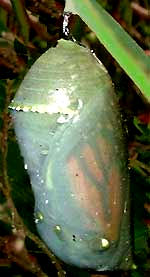 A pupa is the resting stage between the larva and adult stages of insect species undergoing complete metamorphosis. Remember:
A pupa is the resting stage between the larva and adult stages of insect species undergoing complete metamorphosis. Remember:
EGG  LARVA
LARVA  PUPA
PUPA  ADULT
ADULT
The most famous kinds of pupae (the plural can also be pupas) are those of butterflies, for which the special name of "chrysalis" is used. At the right you see a chrysalis of the Monarch Butterfly. Notice how you can see the Monarch's orange and black wings inside the chrysalis's shell.
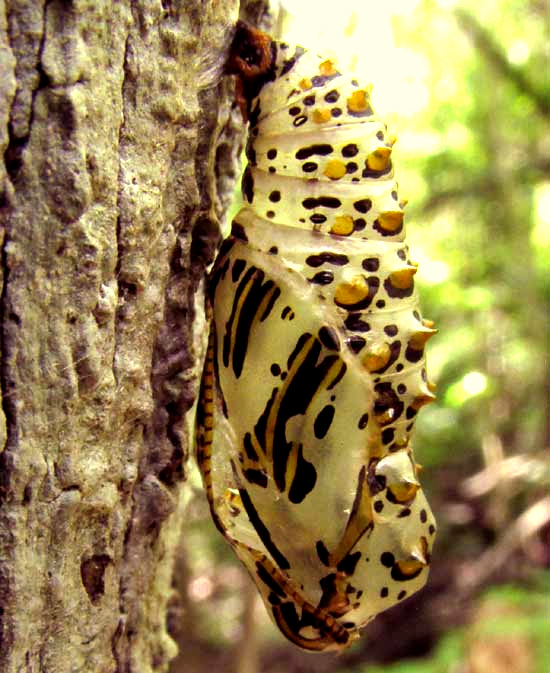
The above picture also shows how the chrysalis is attached at its top to a blade of grass, by a short, white strand of silk. When a caterpillar is fully grown, it attaches its body to a support, with a button of silk. Then the caterpillar's old skin comes off, exposing the hard shell of the chrysalis, and leaving the chrysalis hanging from the support by a strand of silk.
Some chrysalises are beautifully ornamented, such as those of the Variegated Fritillary, Euptoieta claudia, at the left. Actually, that's really just the chrysalis's shell, because the adult butterfly already has emerged from it. At the shell's lower, left, maybe you can see the split through which the adult emerged.
Unlike the Monarch chrysalis's shell, the Variegated Fritillary pupa shell bears little spikes and splotches of color. Also, the shell has a special bulge that accommodated the partly expanded wings on the developing individual inside the shell. The pupa below not only shows where immature wings are folded inside the shell, but also antennae.
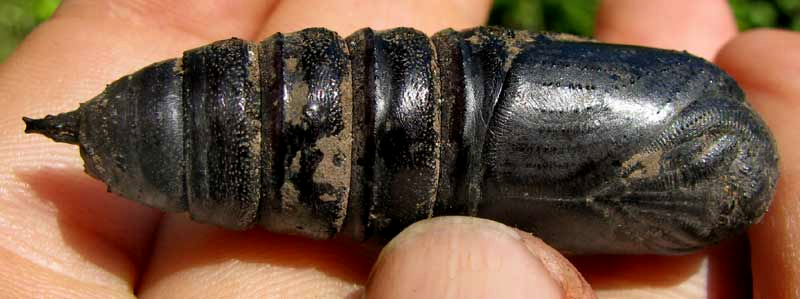
That pupa, found buried in soil with plenty of rotting wood, is of the Imperial Moth, Eacles imperiales. Usually it's understood that butterflies produce chrysalises, but the caterpillars of moths develop into pupas which may be protected by silken cocoons, or , if they develop underground, by hard shells like the above, in which case sometimes they're called cases.
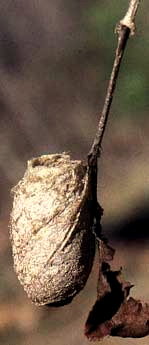
At the left you see the cocoon from which a saturnid moth, of the Giant Silkworm Moth family the Saturniidae, already has emerged. You can see the hole at the top left by the escaping adult. Also notice the neat way a leaf has been incorporated into the cocoon, the leaf's midrib clearly visible bending around the cocoon's bottom.

A bagworm cocoon is shown at the right. Sometimes you can spot such a bag, often called a "case," slowly creeping along a stem. Inside the case, which is camouflaged with various items found nearby, the larva is mostly hidden and protected from birds who might want to eat it. Just the end of the larva's body sticks through a hole in the case, enabling it to move. Once the larva eats and matures enough, then it turns into a pupa, and while it's in the pupa stage the bag stays in one place and protects it. Then one day the bag splits and out comes the adult moth.
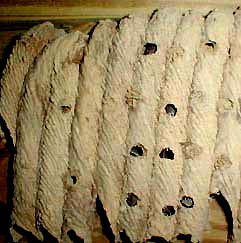
At the left you see the nests of a Mud-dauber Wasp (family Sphecidae, subfamily Trypoxyloninae). Mud daubers construct such nests from mud. The nests are partitioned off with mud and each cell is provisioned with several paralyzed spiders implanted with the mother wasp's eggs.
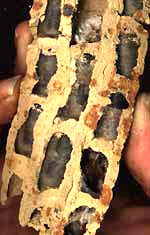 After the eggs hatch the larvae feed on the spiders, and mature in about three weeks. Then the larvae pupate inside the dried-mud nest and overwinter. Sometimes overwintering mud dauber nests fall off, as the one shown at the right did, and you can see into the nest's cells. Can you see the smooth, dark-gray pupas inside the cells? The cells at the bottom, right and top, middle, are empty, for comparison.
After the eggs hatch the larvae feed on the spiders, and mature in about three weeks. Then the larvae pupate inside the dried-mud nest and overwinter. Sometimes overwintering mud dauber nests fall off, as the one shown at the right did, and you can see into the nest's cells. Can you see the smooth, dark-gray pupas inside the cells? The cells at the bottom, right and top, middle, are empty, for comparison.
